- Tringa melanoleuca
Identification
Length 29–33 cm (11½-13 in), wingspan 70-74 cm, weight 110-235 g
- Dark brown streaks on head and neck
- Long, bright chrome yellow legs
- Square white rump, not extending in an inverted 'V' up the back
- Upperpart feathering strongly spangled white in breeding plumage, slightly drabber in winter plumage
Similar Species
- Easily confused with Lesser Yellowlegs, but obviously larger (29-33 cm length, vs 23-25 cm). Bill is longer, about 1.5x the size of the head from front to back, where head and bill are about equal in Lesser Yellowlegs; bill is also stronger and often slightly upturned, and with a paler base (needle-straight, and all black in Lesser). Legs are proportionately stronger, especially the "heel" (often mis-called the "knee").
- Common Greenshank is structurally very similar, about the same size and with similar paler-based, slightly upturned bill; it differs obviously in dull greenish legs, less white spotting on the upperpart feathers, and in flight by the white rump extending in a long inverted 'V' up the back.
Distribution
Breeds Alaska and Canada
Winters to southern South America
A rare vagrant to the western and eastern fringes of the Old World; much rarer (less than annual) there than Lesser Yellowlegs.
Taxonomy
Genetically, its closest relative is the Common Greenshank (which also replaces it ecologically in the Old World); this species pair is next most closely related to Spotted Redshank[2].
Subspecies
This is a monotypic species[1].
Habitat
Tidal marshes, salt pans, muddy estuaries, freshwater lakes and streams.
Behaviour
Diet
Aquatic and land insects, small crustaceans, fish and worms.
Breeding
They lay 4 eggs in a ground nest.
Vocalisation
Call: tyew_tyew_tyew, similar to Common Greenshank.
Movements
Migration through interior North America and along coasts, on both passages.
References
- Clements, J. F., T. S. Schulenberg, M. J. Iliff, S. M. Billerman, T. A. Fredericks, B. L. Sullivan, and C. L. Wood. 2019. The eBird/Clements Checklist of Birds of the World: v2019. Downloaded from http://www.birds.cornell.edu/clementschecklist/download/
- Pereira, S. L., & Baker, A. J. (2005). Multiple Gene Evidence for Parallel Evolution and Retention of Ancestral Morphological States in the Shanks (Charadriiformes: Scolopacidae). The Condor, 107(3), 514-526
- Van Gils, J., Wiersma, P. & Kirwan, G.M. (2020). Greater Yellowlegs (Tringa melanoleuca). In: del Hoyo, J., Elliott, A., Sargatal, J., Christie, D.A. & de Juana, E. (eds.). Handbook of the Birds of the World Alive. Lynx Edicions, Barcelona. (retrieved from https://www.hbw.com/node/53906 on 17 February 2020).
- Elphick, C. S. and T. L. Tibbitts (1998). Greater Yellowlegs (Tringa melanoleuca), version 2.0. In The Birds of North America (A. F. Poole and F. B. Gill, Editors). Cornell Lab of Ornithology, Ithaca, NY, USA. https://doi.org/10.2173/bna.355
- BirdForum Member observations
Recommended Citation
- BirdForum Opus contributors. (2025) Greater Yellowlegs. In: BirdForum, the forum for wild birds and birding. Retrieved 11 May 2025 from https://www.birdforum.net/opus/Greater_Yellowlegs
External Links
GSearch checked for 2020 platform.1







